E-commerce Email Marketing: Boost Open Rates by 15% Next Quarter

E-commerce email marketing is vital for increasing open rates by 15% in the next quarter through personalized content, strategic segmentation, A/B testing subject lines, optimizing send times, and cleaning your email list to enhance engagement and avoid spam filters.
Want to skyrocket your e-commerce email marketing open rates? It’s not just about sending emails, it’s about sending the right emails, to the right people, at the right time. This guide, **e-commerce email marketing: how to increase open rates by 15% in the next quarter**, will give you actionable strategies to boost your engagement and drive sales.
Understand Your Audience for E-commerce Email Marketing
The foundation of any successful e-commerce email marketing strategy lies in understanding your audience. By knowing who you are targeting, you can tailor your messages for maximum impact.
собирать данные об аудитории
Collecting audience data is the first step. Use analytics tools to understand your customers’ demographics, purchase history, and browsing behavior.
Сегментировать свою аудиторию
Segmentation allows you to send targeted emails based on specific criteria. This increases relevance and engagement.
- Segment by purchase history: Target customers who have bought specific products or product categories.
- Segment by demographics: Tailor messages based on age, location, and gender.
- Segment by engagement: Reward active subscribers and re-engage those who are less active.
- Segment by website behavior: Target those who have browsed certain products or abandoned their cart.
Understanding and segmenting your audience are crucial for creating effective e-commerce email marketing campaigns. By tailoring your messages to specific groups, you can increase open rates and drive more sales.

Craft Compelling Email Subject Lines
The subject line is the first thing your subscribers see, and it can make or break your email’s success. A compelling subject line grabs attention and entices recipients to open your email.
Keep It Short and Sweet
Mobile devices often truncate long subject lines. Aim for under 50 characters to ensure your message is fully visible.
Use Personalization
Personalized subject lines can significantly increase open rates. Address subscribers by name or reference past purchases.
- Include the subscriber’s name: Use merge tags to automatically insert the recipient’s name.
- Reference past purchases: “Enjoyed your last [Product]? Check out these related items!”
- Use location-based personalization: “Local Deals in [City Name] Just for You!”
Crafting compelling subject lines is an art. By keeping them short, using personalization, creating a sense of urgency, and A/B testing different approaches, you can dramatically improve your email open rates.
Personalize Email Content for Better Engagement
Generic emails are easily ignored. Personalizing email content makes subscribers feel valued and increases their engagement with your brand.
Customize Product Recommendations
Suggest products based on past purchases, browsing history, or items added to their wishlist.
Use Dynamic Content
Dynamic content changes based on the recipient’s data, ensuring relevance and engagement.
- Display different content based on demographics: Show different products to male and female subscribers.
- Tailor offers based on purchase history: Offer discounts on products related to their past purchases.
- Customize content based on location: Display local events or promotions.
Personalizing email content is essential for building strong relationships with your subscribers. By customizing product recommendations, using dynamic content, and creating exclusive offers, you can significantly increase engagement and drive sales.

Optimize Send Times for Maximum Visibility
Sending emails at the right time can dramatically improve open rates. Understanding when your audience is most active ensures your messages are seen.
Analyze Your Data
Use email marketing analytics to determine when your subscribers are most likely to open your emails.
Consider Time Zones
If your audience spans multiple time zones, segment your list and schedule emails accordingly.
- Send emails based on local time: Schedule emails to arrive in each time zone during peak hours.
- Use A/B testing to find the best send times: Experiment with different send times to see what works best.
- Monitor open rates and adjust accordingly: Continuously refine your send times based on performance data.
Optimizing send times is a crucial step in improving your email open rates. By analyzing your data, considering time zones, and using A/B testing, you can ensure your messages reach your subscribers at the most opportune moments.
Clean Your Email List Regularly
A clean email list is a healthy email list. Regularly removing inactive subscribers and invalid email addresses improves your sender reputation and deliverability.
Remove Inactive Subscribers
Subscribers who haven’t engaged with your emails in a long time can hurt your open rates and sender reputation.
Verify Email Addresses
Use email verification tools to identify and remove invalid email addresses.
- Implement a double opt-in process: Ensure subscribers confirm their email address before being added to your list.
- Regularly remove hard bounces: Immediately remove email addresses that result in hard bounces.
- Use re-engagement campaigns: Try to re-engage inactive subscribers before removing them from your list.
定期清洗您的电子邮件列表对于维护良好的发件人信誉和交付能力至关重要. 通过删除不活跃的订阅者和验证电子邮件地址, 您可以提高打开率并避免垃圾邮件过滤器.
Utilize A/B Testing to Refine Your Strategies
A/B testing, also known as split testing, allows you to experiment with different elements of your email campaigns to see what resonates best with your audience.
Test Subject Lines
Experiment with different subject lines to see which ones generate the highest open rates.
Test Email Content
Try different layouts, images, and calls to action to see what drives the most engagement.
- Test different layouts: Experiment with single-column and multi-column layouts.
- Test different images: Use different product images or lifestyle photos.
- Test different calls to action: Try different button colors, text, and placement.
A/B testing is a powerful tool for refining your e-commerce email marketing strategies. By continuously experimenting with different elements and analyzing the results, you can optimize your campaigns for maximum impact.
| Key Point | Brief Description |
|---|---|
| 🎯 Audience Understanding | Segment your audience based on behavior, demographics, and purchase history. |
| ✉️ Subject Line Optimization | Craft concise, personalized, and urgent subject lines to increase open rates. |
| ⏱️ Send Time Optimization | Analyze data to determine the best send times for your audience across different time zones. |
| 🧹 List Cleaning | Regularly remove inactive subscribers and verify email addresses. |
Frequently Asked Questions (FAQ)
▼
Audience segmentation allows you to send more targeted and relevant emails, which leads to higher open rates, click-through rates, and ultimately, more sales. Generic emails are less likely to resonate with your audience.
▼
You should clean your email list regularly, ideally every three to six months. This helps maintain a healthy sender reputation and improves deliverability by removing inactive or invalid email addresses.
▼
Effective A/B testing strategies include testing different subject lines, email layouts, images, and calls to action. Analyze the results to see which variations perform best and implement those changes in future campaigns.
▼
Personalization makes your emails more relevant to each subscriber, increasing the likelihood they’ll open and engage with your content. Use personalized subject lines, product recommendations, and dynamic content to tailor the experience.
▼
Several tools can help analyze email marketing performance, including Google Analytics, Mailchimp, HubSpot, and Sendinblue. These tools provide insights into open rates, click-through rates, conversion rates, and other key metrics.
Conclusion
Boosting e-commerce email marketing open rates by 15% in the next quarter requires a strategic approach that combines audience understanding, personalized content, send time optimization, list cleaning, and A/B testing. By implementing these tactics, you can create more engaging and effective email campaigns that drive sales and build stronger customer relationships.





